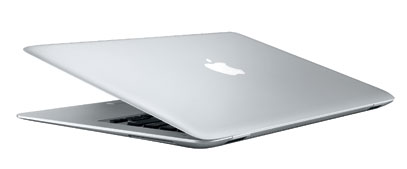MacBook Air Introduced as World’s Thinnest Notebook
Billing it as the world’s thinnest notebook computer, Apple announced the MacBook Air, a 3-pound Mac that fills out the company’s portable line between the inexpensive MacBook at the low end and the powerful MacBook Pro at the high end. During his keynote address at Macworld Expo, Steve Jobs demonstrated the new machine’s slim profile by sliding it out of a standard interoffice manila envelope (a trick that also appears in a new television ad). The slightly wedge-shaped computer ranges in thickness from 0.76 inches (19.3mm) on the hinge side to a mere 0.16 inches (4mm) at the front.
The MacBook Air offers many whizzy features that you’d expect from a new Apple laptop: a full-size, backlit keyboard with an ambient light sensor; a built-in iSight camera; 802.11n and Bluetooth 2.1 + EDR (Enhanced Data Rate) wireless support; a magnetic latch; and a 45 watt power adapter with a MagSafe connector (note that the MagSafe connector is slightly different from previous MagSafe connectors). Its “generously sized” trackpad borrows gesture support from the iPhone’s multi-touch display, meaning that with various combinations of finger movements you can zoom, pan, rotate photos, move windows, and perform other actions without having to worry about the exact location of your mouse pointer or manipulating tiny on-screen controls.
The gestures can be turned off and on in the Trackpad view of the Keyboard & Mouse preference pane.
Apart from the power connector, the only physical interfaces on the MacBook Air (all hidden beneath a small flip-down door) are a single USB 2.0 port, a micro-DVI video port, and a headphone jack. Notably absent is an Ethernet port, although Apple offers a $29 USB-to-Ethernet adapter as an option. In addition, the MacBook Air is the first Apple computer since 2000 not to include any form of FireWire port, and it lacks even a slot for a security cable (a real pity given how tempting it will be to swipe one of these machines). Another interesting omission is that of an Apple Remote, though users can purchase one for an additional $19.
The MacBook Air features a glossy 13.3-inch, 1280-by-800-pixel display with LED backlighting – the same physical size and resolution as the existing MacBook’s display. At Apple’s request, Intel created a special version of the Core 2 Duo CPU for the MacBook Air; the processor is 60 percent smaller than those in Apple’s other laptops. It’s also slower, with the base model clocking in at only 1.6 GHz, plus an option to switch to a 1.8 GHz processor. The computer comes standard with 2 GB of RAM, which is not upgradeable.
In order to save space, the MacBook Air uses a 1.8 inch hard drive (the same size found in some iPod models). The standard configuration features an 80 GB, 4200-rpm drive. However, Apple also offers, for the first time, a 64 GB solid-state drive, which is somewhat faster – especially compared to the relatively slow 1.8-inch drive – and enormously more shock-resistant, and has slightly lower power requirements (though at a significantly higher price). (Reportedly, the 160 GB drive found in the high-end iPod Classic – which uses two platters for storage – is too tall to fit into the MacBook Air’s svelte case.)
Apple claims 5 hours of battery life for the MacBook Air, even with wireless networking active; Apple told us that battery life could be increased slightly by disabling Wi-Fi and Bluetooth. Although one would suspect that figure would increase with the solid-state drive option, Apple said in a briefing that the difference is negligible. It’s a good thing the battery life is so long, too, since the battery is not removable – another first in an Apple laptop. It can be replaced at an Apple Store for $129 without being sent in for service, Apple said. The battery, like that of the iPhone, is expected to retain at least 80 percent of its capacity after hundreds of complete recharge cycles.
The machine has no optical drive, though an external USB SuperDrive is available for $99. However, Apple thinks most users won’t need one, thanks to a new technology called Remote Disc, which enables the MacBook Air to mount CDs and DVDs inserted in other computers – even Windows PCs – with the permission of the computer’s owner. A preference can also be set to allow automatic mounting.
Remote Disc even allows network-based installation and upgrade of Mac OS X through a network boot, a feature previously found only in Mac OS X Server, meant as a tool for network administrators. This feature requires a choice at startup – probably holding down certain keys as with the server-based Net Install – that we were unable to determine by publication time.
Remote Disc can share discs on any Tiger, Leopard, Windows XP, or Windows Vista system. However, Apple told us that Remote Disc would work for mounting only on a MacBook Air. We hope Apple expands the availability of the feature – likely requiring firmware changes in other models – as an additional option for flexibility and disaster recovery for other Mac owners.
Steve Jobs made a special point of enumerating the environmentally friendly features of the MacBook Air. It has a fully recyclable aluminum case; a mercury-free display with arsenic-free glass; circuit boards that are BFR-free and PVC-free; and retail packaging that occupies 56 percent less volume than that of the existing MacBook. These changes were well-received by the audience, though Greenpeace is still pushing Apple to go even further, perhaps to a fully compostable Mac.
Apple is now accepting pre-orders for the MacBook Air, which Jobs said would begin shipping two weeks following the announcement. The base model, with an 80 GB hard drive and a 1.6 GHz processor, costs $1,799. Swapping the hard drive for the 64 GB solid state drive adds a whopping $999 to the price, while upgrading to a 1.8 GHz processor adds $300.
